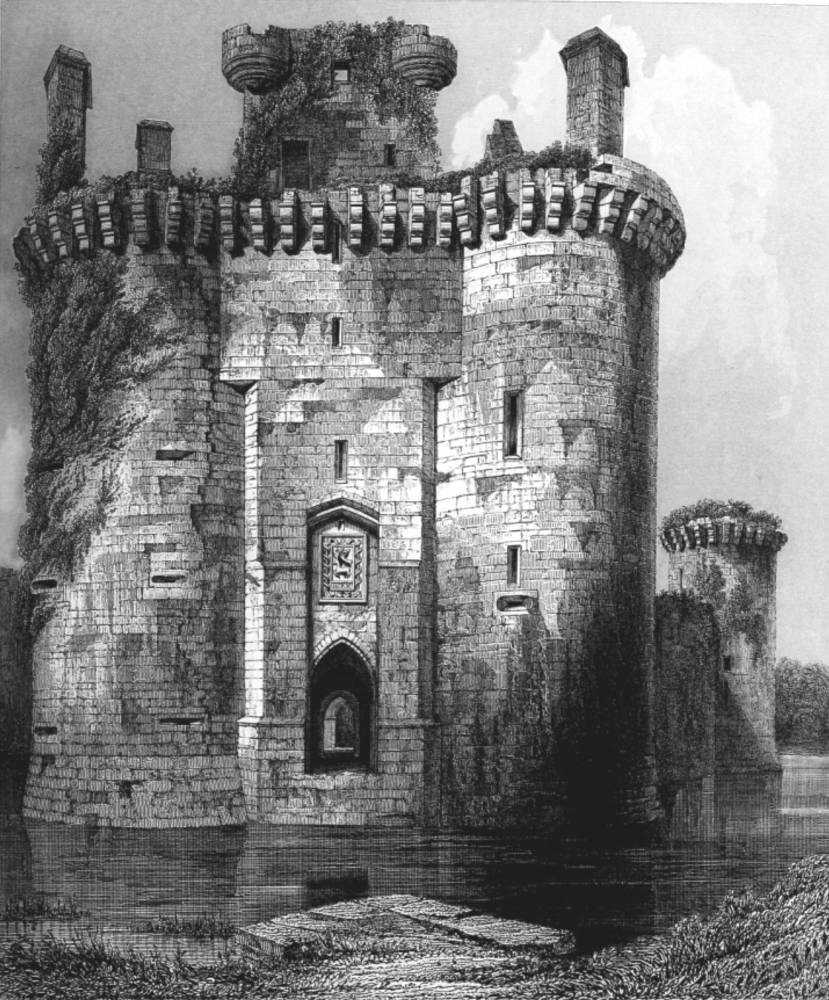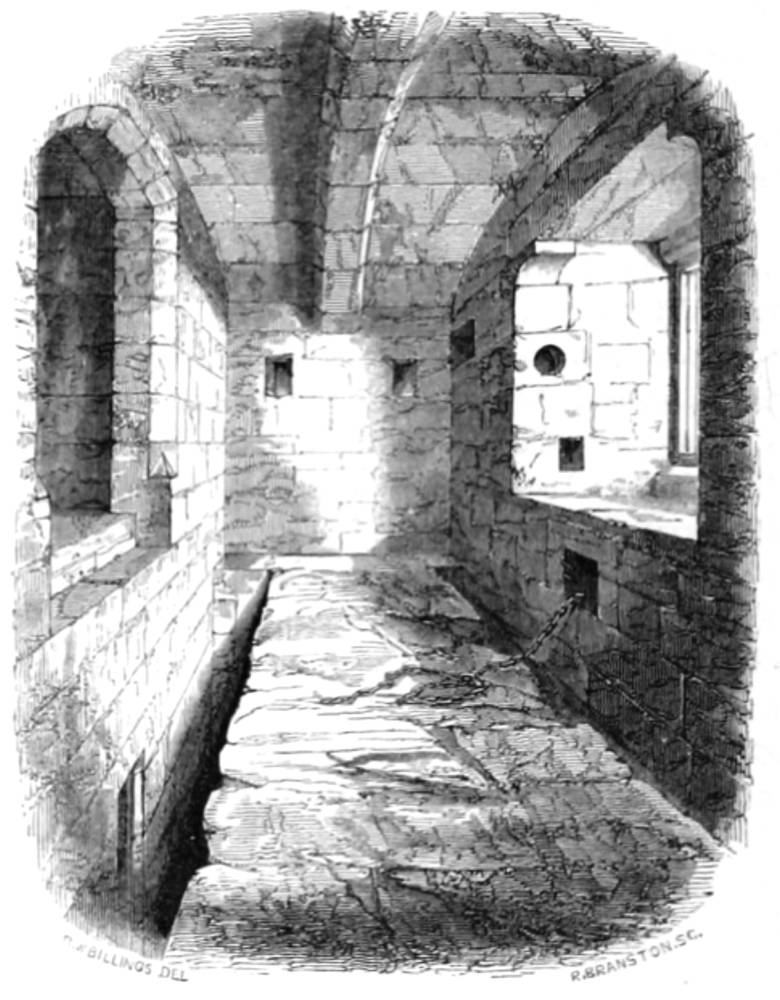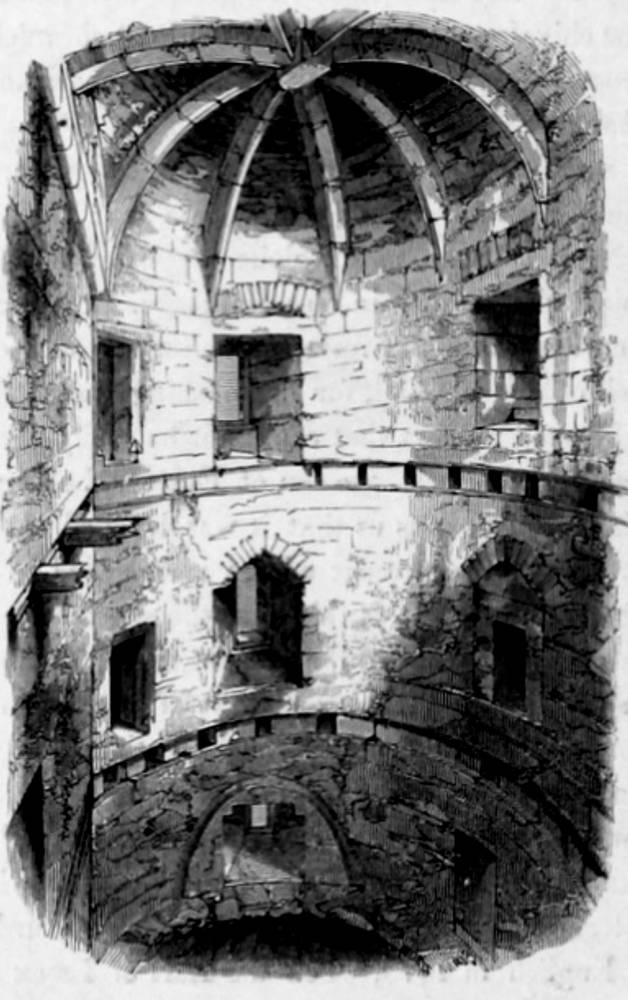[These images may be used without permission for any scholarly or educational purpose without prior permission as long as you credit the Hathitrust Digital Archive and the Duke University Library and link to the the Victorian Web in a web document or cite it in a print one — George P. Landow ]

Caerlaveroc Castle drawn by Robert William Billings (1814-1874) and engraved by J. Godfrey. Source: The Baronial and Ecclesiastical Antiquities of Scotland (1852). Note the people in nineteenth-century costume in the center forground and the homel;y touch of what seems to be sheets drying on a clothes line. [Click on image to enlarge it.]
Commentary by the Artist
The Scottish reiver, or free-booter, usually perched his stronghold on the top of an isolated rock or by the edge of a ravine; and he derived so much security from these natural peculiarities, that they came to be considered indispensable to a real fortress. It must have been seen, however, that in England, where a rocky foundation could more rarely be obtained, the great fens and morasses afforded a means of protection from hostile invasion, as effectual as precipices or torrents; and occasionally we find, in Scotland, defensible positions of this character successfully adopted. Thus the flat sandy shores of Dumfriesshire could boast of at least one strong position which, close to the junction of two rivers, had the swelling Solway on one side, and the pathless wastes of Lochar Moss on the other. It was important that the peninsula thus guarded from without should be internally commanded by a fortified place, and thus, from a very early period rose the towers of Caerlaveroc, “not many feet above high-water mark” (New Statistical Account — Dumfries, 351). The extent to which the available materials of a flat site near abundance of water had been adapted to defensive purposes, is indicated by the ample remains of the old moats, whence the people of the country call the spot the Island of Caerlaveroc. The great gateway pierces a narrow curtain between two machicolated round towers of old baronial architecture; and one of the round towers at the other two angles of the triangular plan to which the edifice was adjusted, still remains. A considerable portion of the intervening buildings have the canopied and sculptured window cases of the domestic architecture of the reign of James VI., and remind one of Linlithgow Palace and Heriot's Hospital.

Entrance, Gateway, & Flanking Towers. . Drawn by R. W. Billings and engraved by J. H. Le Keux. Click on image to enlarge it.
The site of this castle has been identified by antiquaries with the Carbantorigum of Ptolemy's Geography. A tradition relating to a period four centuries later than the era of the geographer, with far less probability, states that the castle was founded by Lewarch Og, son of Lewarch Hen, a poet of celebrity, from whom it was termed Caer Lewarch Ogg, signifying, in Cambro-Celtic, the city or fortress of Lewarch Ogg (Grose's Antiquities, I, 159). Passing over a period of six centuries, we come within the range of authentic records, which, in showing that the barony was acquired by Sir John Macuswell about the year 1220, and that it has, since that time, remained in possession of the Maxwell family, prove it to be one of the oldest of the well-authenticated hereditary family possessions in Scotland (Douglas's Peerage, II, 312). The fortress became afterwards memorable in the national war against Edward I., who, when he overran Galloway with his invading army in June 1300, laid formal siege to Caerlaveroc Castle, which yielded after a long resistance, against which the highest engineering science of the age appears to have been directed. Although but briefly recorded by the ordinary annalists, this siege has been resuscitated in later times as a memorable event, by the discovery in the British Museum of a contemporary rhythmic narrative of the conflict, minutely set forth in Norman French. It is attributed, by its editor, to Walter of Exeter, a Franciscan friar, who, about the year 1292 wrote the history of Guy of Warwick. This production, like most narrative poems of a rude literary age, is in a great measure a descriptive catalogue of the several leaders in the attack, and it greatly excited the heraldric enthusiasm of its editor, Sir Harris Nicolas, who says,
It contains the accurate blazon of about one hundred knights or bannerets of the reign of Edward the First, among whom were the King, the Prince of Wales, and the greater part of the peers of the realm. At the same time that this production may, perhaps, be considered the earliest blazon of arms which is known, it affords evidence of the perfect state of the science of heraldry at that early period, and from which it is manifest that it was reduced to a science, when it is generally considered to have been but in its infancy. [Preface to “The Siege of Carlaverock”]
The narrative affords us this picturesque description of the besieged fortress: —
Carlaverock was so strong a castle that it did not fear a siege, therefore the king came himself because it would not consent to surrender. But it was always furnished for its defence whenever it was required, with men, engines, and provisions. Its shape was like that of a shield, for it had only three sides all round, with a tower on each angle; but one of them was a double one, so high, so long, and so large, that under it was the gate, with a draw-bridge, well made and strong, and a sufficiency of other defences. It had good walls and good ditches, filled to the edge with water; and I believe there never was seen a castle so beautifully situated, for at once could be seen the Irish Sea towards the west, and to the north a fine country surrounded by an arm of the sea, so that no creature born could approach it on two sides without putting himself in danger of the sea. [Translation by Sir H. Nicolas, p. 61]
We have a systematic and minute description of all the operations of the siege, which shows that, if the science of heraldry was then at maturity, that of reducing fortified places was truly in its infancy. Perhaps the worthy chronicler little dreamed that to a distant posterity these wonderful operations would appear like a theatrical pageant, or some rough schoolboy game. Before the siege began “might be seen houses built without carpenters or masons, of many different fashions, and many a cord stretched, with white and coloured cloth, with many pins driven into the ground, many a large tree cut down to make huts.” On the first attack the besieged seem to have done some execution, whereon
when the men-at-arms saw that the footmen had sustained such losses who had begun the attack, many ran there, many leaped there, and many used such haste to go, that they did not deign to speak to any one. Then might there be seen such kind of stones thrown as if they would beat hats and helmets to powder, and break shields and targets in pieces; for to lull and wound was the game at which they played. Great shouts arose among them when they perceived that any mischief occurred. Many a heavy and crushing stone [we are told] did he of Kirkbride receive, but he placed before him a white shield with a green cross engrailed. So stoutly was the gate of the castle assailed by him, that never did smith with his hammer strike his iron as he and his did there. Notwithstanding there was showered upon them such huge stones, quarrels, and arrows, that with wounds and bruises they were so hurt and exhausted, that it was with great difficulty they were able to retire. [67, 77. Where Nicholas translation has “hats,” the original reads chapeaus — meaning, of course, hats made of iron— author's note.]
At last the garrison, desiring to surrender, showed a flag of truce; "but he that displayed it was shot with an arrow by some archer, through the hand into the face.” The smallness of the garrison seems to have astonished even the besiegers, and is a remarkable evidence of the preponderating value in those days of even such rude fortifications, as the remains of ancient castellated architecture exhibit. “And this is the number of those who came out of it; of persons of different sorts and ranks, sixty men, who were beheld with much astonishment, but they were all kept and guarded till the king commanded that life and limb should be given them, and ordered to each of them a new garment” (87). Such is the chivalrous spirit in which the Poet chronicler describes the conclusion; but the chronicle of Lanercost, in closer conformity with the character of the victor, states that many of the captives were hanged.


Both untitled woodcuts are by R. W. Billings, and the one on the left was engraved by R. Branstone; the one at right has no inscriptions. [Click on images to enlarge them.]
The castle remained for some years in possession of the conquerors. It must, however, have speedily again fallen into the hands of the Scots; for in the year 1312 it appears to have been in the custody of Sir Eustace Maxwell, who, as a zealous supporter of Bruce, subsequently defended his paternal possession against the English in a second siege. He successfully resisted them, but deemed it wise to destroy or dismantle the fortress; and there existed a charter of Robert the Bruce "to Eustace Maxwell of ane annuall, for demolishing the castle of Carlaverock” (Robertson's Index to the Charters, p. 15). The destruction appears to have affected no part that could not be easily repaired, for amid the fluctuations of that shifting time, we find Herbert, the son of Eustace, holding the castle as liege man of Edward III., in 1347. Major briefly tells us that it was levelled to the ground by Bojer Kirkpatrick in 1355. The older part of the present edifice is supposed to have been erected near the conclusion of the fourteenth century. If It is said that the site of the old castle, which stood the sieges, was at some distance even from that of the present ruin; but there are portions of the edi- fice bearing the stamp of an antiquity far beyond that of the majority of Scottish castellated edifices; and it is worthy of note, that the peculiarities mentioned by the chronicler of the siege are still exhibited in the ruin as features of the original plan.
In 1424, Caerlaveroc became the prison of Murdoch, Duke of Albany,** being probably considered as safely distant from his retainers in Perthshire, and the nobles with whom he was in confederacy (Tytler's History, III, 71). The round tower at the western angle is still traditionally called “Murdoch's Tower.” The castle was again besieged by the English in 1570, when the Earl of Essex passed the border with an army, after the murder of the Regent Hurray. The castle was repaired, and probably the more modern part of it built, by the Earl of Xithisdale in 1638 (Grose, I, 162). Two years afterwards, it was besieged by the Covenanting army, and was yielded up to them by the King's instruction, in a capitulation dated 1st October 1640. Lord Nithisdale, who was both governor and owner of the fortalice, in which he commanded a garrison of 100 men, gave up possession to Colonel Home, after preparing "a note of such things as were left in the house of Carlaveroc at my lord's departure," — like the inventory of a furnished house given up to a tenant (Grose, I, 164). The Earl afterwards charged Home with having “intromitted” " with his goods and effects — an expression used by the Scottish law in reference to one who takes possession of property to which he has a questionable right. The list is very specific, as the following specimen will show: —
Item, He has intrornitten with twa open trunks full of Holland shirts, and pillabers and dorock — damask table-cloths, and gallons, and towells, to the number of forty pair of sheets or thereby, and seventy stand of napery. Every pair of sheets consisting of seven ells of cloth at six shillings sterling the ell, amounts to £5, 2s. ster. the pair. Inde, £704 sterling.
Item, The stand of neprey, consisting of ane table-cloth, of twa dozen of nepkins, twa laug towells, (estimate to xx pound ster.)
Item, He has intrornitten with ane knock that stands upon ane table, estimate to xx pound sterling.
R. W. B.
Bibliography
The Baronial and Ecclesiastical Antiquities of Scotland illustrated by Robert William Billings, architect, in four volumes.. Edinburgh and London: William Blackwood and Son, 1852. Hathitrust Digital Archive version of a copy in the Duke University Library. Web. 19 October 2018.
Last modified 19 October 2018